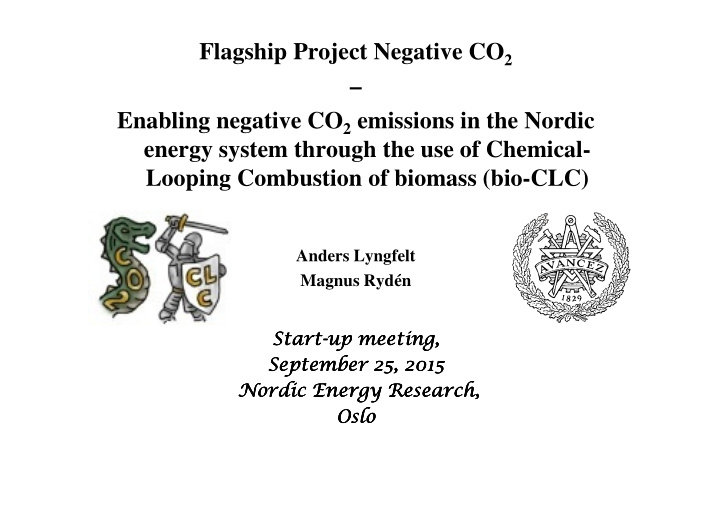



Flagship Project Negative CO 2 – Enabling negative CO 2 emissions in the Nordic energy system through the use of Chemical- Looping Combustion of biomass (bio-CLC) Anders Lyngfelt Magnus Rydén ����� ����� ������ ����� � ���� � ������������ ��� ��� ��������� ��������� ��������� ���������������������� ���������������������� ���������������������� ���������������������� ������������������������ ������������������������ ������������������������ ������������������������ ���� ���� ���� ����
Part 1. Introduction and Background (Anders) • Why BECCS ? • The need for BioEnergy Carbon Capture and Storage • Why CLC? • What’s special with Chemical-Looping Combustion ? • Why Nordic Countries ? • Are the costs reasonable ? Part 2. Project Description (Magnus)
�������� ����������������� �������� �������� ��������� ��������� ��������� ������ ������ ������ ������� ������ ������� ������� ������� �� �� �� ��������� �������� ������� ������� � � � ATMOSPHERE CO2 CO2 CO2 fossil fuels carbon capture biomass biomass with carbon capture GROUND
To meet the 2ºC target it is not sufficient to stop emissions of CO 2 , most likely we need negative emissions by the end of the century. Emissions falling before 2020 50-90% reduction by 2050 After 2070: totally negative emissions
IPCC report: Models reaching the 2ºC target needs (101 of 116): � Totally negative emissions beyond 2060-2080, <20 Gt CO 2 /yr � Negative emissions of 2-10 Gt CO 2 /yr already in 2050 Compare: Biomass 10% of energy supply 2012 (IEA), => 5-6 Gt CO2 /yr From: Fuss et al., Nature Climate Change, 4 (2014) 850-853
CCS status Three main technologies 1 , all having � large energy penalties, around 10%-units � significant need for gas-separation equipment � cost normally estimated to 50 €/tonne CO 2 First commercial large post-oxidation in operation � 1 year (Boundary Dam, Canada) Large-scale precombustion being built (Kemper, � US) 2016 Oxyfuel, planned, not decided (White Rose, UK) � 2020 ? 1 post-, pre- and oxycombustion
Anders Lyngfelt, Chalmers University of Technology Unit 3, with CO 2 capture CO 2 Absorption stripper tower Boundary Dam, Canada Heat First power plant compression exchangers, with CO 2 capture amine 1 Mtonne CO 2 /year regeneration
removed by $����������� $�����������% $����������� $����������� % %���������������������&���' % ���������������������&���' ���������������������&���' ���������������������&���' condensation � � � � N 2 , O 2 CO 2 , H 2 O ���������������������������������� ���������������������������������� ���������������������������������� ���������������������������������� ����������������������������� ����������������������������� ����������������������������� ����������������������������� MeO (+ Me) ����������� ����������� ����������� � ����������� � ������� � ������� � ������� � ������� � � � Air Fuel ! ������������������������ ��"��� reactor reactor ����� Me (+ MeO) ! �������"����������������� ������ ! �����������#�������������������� Air Fuel ����������������"������ ( )����������������������*���������������������� )����������������������*���������������������� )����������������������*���������������������� )����������������������*���������������������� � � ������� ������� ������� ������� � � ( ���+����������,��*�������������' ���+����������,��*�������������' ���+����������,��*�������������' ���+����������,��*�������������'
������������������������������ flue gas cooling flue � � � � gases 2 CO2, H2O ������������������ 1 reactor 4 � system � � � 3 1 4 � � � � filters fuel air ������������������������ ����������������������������
Chalmers’ 100 kW CLC for solid fuel, 2011 AR=Air reactor, FR=fuel reactor, LS=loop seal, C=cyclone, CS=Carbon stripper, CR=Circulation riser
Where are we ? � CLC operation worldwide � 24 pilots : 0.3 kW – 3 MW � >7500 h with >70 oxygen carriers � 4400 h at Chalmers with >50 oxygen carriers � CLC with solid fuels � Low cost oxygen carriers can be used � Incomplete conversion/capture � Some oxy-polishing needed, estimate: 5-15% � Up to 98% CO 2 capture attained � 400 h operation at Chalmers (10 kW and 100 kW)
1000 MW th reference CFB: Depth 11 m Height 48 m Reference Width 25.5 1000 MW th CLC: Depth 11 m Height 48 m Air Reactor Width 25 Fuel Reactor • fuel reactor: Air • Reactor 11×7 m From: Lyngfelt, A., and Leckner, B., A 1000 MWth Boiler for Chemical-Looping Combustion of Solid Fuels - Discussion of Design and Costs, Applied Energy in press (available on-line)
Detailed cost analysis of CLC, based on difference with CFB Type of cost estimation, range, €/tonne CO 2 Efficiency penalty, €/tonne CO 2 % CO 2 compression 10 10 3 Oxy-polishing 6.5 4-9 0.5 Boiler cost 1 0.1-2.3 - Oxygen carrier 2 1.3-4 - Steam and hot CO 2 0.8 0.8 0.8 fluidization Coal grinding 0.2 0.2 0.1 Lower air ratio -0.5 -0.5 -0.5 Total 20 15.9-25.8 3.9 From: Lyngfelt, A., and Leckner, B., A 1000 MWth Boiler for Chemical-Looping Combustion of Solid Fuels - Discussion of Design and Costs, Applied Energy in press (available on-line)
Estimated cost of CLC, less than half of competing technologies Should be suitable for biomass. - larger biomass boilers normally use CFB technology
�� �� �� �� � � �����������������������-��������������� �����������������������-��������������� �����������������������-��������������� �����������������������-��������������� � � CO 2 emissions, sources >100 000 tons/year >50 Mt/year biogenic total Nordic fossil CO2 emissions 200 Mt/year
potential storage locations CO 2 biofuel point sources Baltic Sea: storage <15 000 Mt, uncertain
Recommend
More recommend